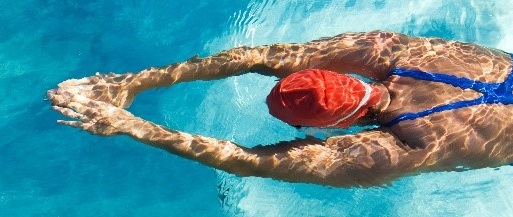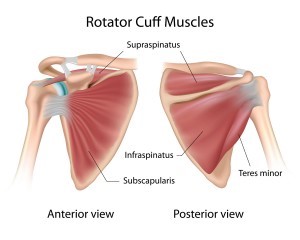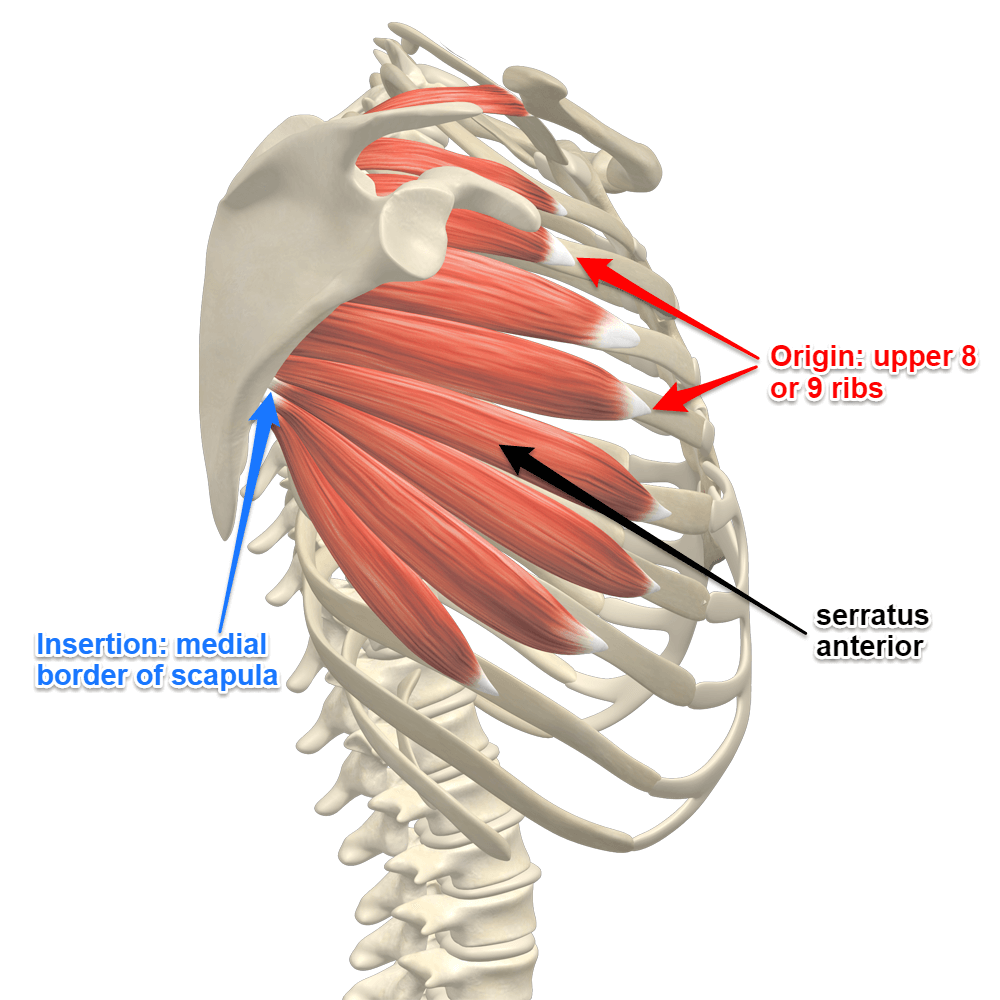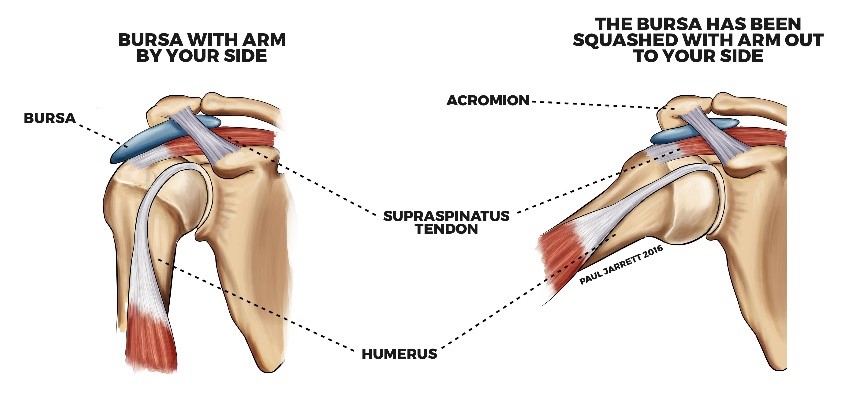
A competitive swimmer averages about 4000 strokes per workout, making shoulder pain the most common complaint in this sport. A study done on 80 Australian elite swimmers aged 13-25 found that 91% of them were experiencing shoulder pain. So why exactly is shoulder pain so common in swimmers, and more importantly, what can you do to prevent it?
What Is Swimmer’s Shoulder?
“Swimmer’s shoulder” is an umbrella term that describes numerous injuries related to swimming and shoulder injuries. It usually has a gradual onset of pain due to repetitive activity, and the causes tend to be multifactorial. When we say multifactorial, we mean that often several things are involved in causing the pain, including;
- Stroke biomechanical abnormalities (i.e. poor stroke technique)
- Overuse, fatigue or improper control and muscle recruitment
- Glenohumeral (shoulder) laxity
Causes Of Shoulder Pain In Swimmers

Shoulder pain is thought to be primarily due to muscular imbalance between the strong dominant muscles (adductors, internal rotators) and the stabilising muscles (rotator cuff). The rotator cuff consists of four muscles that work together to support the shoulder and hold the “ball in the centre of the socket”.
The four rotator cuff muscles are the supraspinatus, infraspinatus, teres minor, and subscapularis. The supraspinatus is mainly used in abduction – moving the arm away from the body. The infraspinatus and teres minor are primarily involved in outwards rotation of the shoulder. The subscapularis is primarily involved in inwards rotation. However, although the individual muscles produce these movements when used separately, the more important job of these muscles is to work together during movement to hold the top of the arm arm bone (humeral head) in the middle of the socket (glenoid labrum). Imbalances in length and/or strength within the rotator cuff muscles means that the humeral head does not stay centralised in the glenoid labrum, which causes shearing across the shoulder joint and can impinge (squash) other structures like cartilage and tendons.

Another important muscle in swimming is the serratus anterior. This muscle helps control the shoulder blade position as it moves around the rib cage during movement, including during swimming. It allows the forward rotation of the arm, pulls the shoulder blades forward and around the rib cage, and helps upward rotation of the shoulder blades.
How Can Swimming Technique Increase Your Chance OF Shoulder Pain?
Swimmers repeatedly load the shoulder in high degrees of elevation (i.e. in an overhead position) and inwards rotation, especially during freestyle and butterfly. The subscapularis, serratus anterior and teres minor are at peak activity at the mid pull-through phase. In addition to inwards rotation of the shoulders, the bigger chest muscle (pectoralis major) and back (latissimus dorsi) get into the action to provide the propulsive force required to pull you through the water. With all this inwards rotation during swimming the muscles that produce this movement can get very strong and tight, creating imbalances in length and strength between the shoulder muscles. As mentioned above, this means that the humeral head is not held consistently in the centre of the socket, especially during forceful movements like pulling your body through the water, and this causes shearing and compression within the shoulder joint.
Muscle Imbalance Is The Main Cause Of Swimmer’s Shoulder Pain
Any action involves an equal and opposite reaction, however, the strengthening and tightening of the inward rotators overpowers the outward rotators. Studies examining shoulder rotation strength have consistently found that an increase in internal rotation strength relative to external rotation strength predisposes a swimmer to shoulder pain and dysfunction. This imbalance of internal to external rotator strength, occurring due to the predominance of inwards rotation loading during the swimming stroke, leads to an inability of the rotator cuff muscles to control the humeral head positioning, increasing the chances of impingement (squashing) and shearing within the shoulder joint.

A study using a video analysis system to document impingement during the freestyle stroke found that impingement occurred just before hand entry and when the hand entered the water. This demonstrated that impingement was very likely in swimmers who have excessive inwards shoulder rotation during the pulling phase, delayed initiation of outwards rotation of the arm during the recovery phase (just before the hand enters the water), and decreased upward rotation of the shoulder blades.
These stroke errors happen when the rotator cuff and shoulder blade stabiliser muscles fail to keep the head of our upper arm bone (humeral head) centred in the socket of our shoulder (glenoid fossa). This leads to excessive shearing of the humeral head within the glenoid fossa, pinching the tendons of supraspinatus and the long head of biceps. In a healthy swimmer’s shoulders, the serratus anterior stabilises the shoulder blades in upward rotation and forwards movement, creating enough space for the biceps tendon and rotator cuff and maintaining good centralisation between the humeral head and shoulder socket.
Several studies comparing muscle activity in swimmer’s shoulders with and without impingement found that there is reduced recruitment of the serratus anterior and teres minor muscles in swimmers with shoulder pain. This results in relative instability in the shoulders because the socket (glenoid fossa) is not maintained in the correct alignment, and therefore the humeral head cannot be kept centralised in the socket.
The swimming stroke requires a highly coordinated pattern of muscles firing at precisely the right time to provide the most efficient and powerful stroke. Plus these muscles must have the right balance of both length and strength for the shoulder mechanics to be optimised. If one muscle changes its firing pattern or becomes weak or tight, it affects the function of all of other muscles in the chain. Doing a stroke incorrectly once may not hurt, but you never just swim one stroke; hundreds of strokes build up over time, and bad technique can catch up on you.
Preventing Shoulder Pain In Swimmers
The cause of swimmer’s shoulder pain for most swimmers is not a lack of brute strength, but rather incorrect muscle recruitment patterns and poor flexibility. Therefore, pre-habilitation is so important to bulletproof the shoulder muscles that are the most vulnerable to injury, whilst strengthening the back muscles to provide the propulsive force needed in the swimming stroke.
In part II of this series on how to bulletproof your shoulders we will discuss foundation muscle activation exercises for the shoulder blade stabiliser muscles and rotator cuff. These are exercises that you can do immediately before swimming to prepare the shoulder muscles to perform effectively during your session. We will also review exercises to strengthen not only the major muscles used for swimming, but also the opposing muscle groups and smaller stabilisers that often get left behind during swimming training and therefore get relatively weak. Working on these often-forgotten muscles is critical to correct imbalances, prevent injuries and maximise your performance.
References
Heinlein, S., & Cosgarea, A. (2020). Biomechanical Considerations in the Competitive Swimmer’s Shoulder. Retrieved 20 April 2020, from http://Biomechanical Considerations in the Competitive Swimmer’s Shoulder.
Tovin, B. (2020). Prevention and Treatment of Swimmer’s Shoulder. PubMed Central (PMC). Retrieved 18 April 2020, from https://www.ncbi.nlm.nih.gov/pmc/articles/PMC2953356/..

